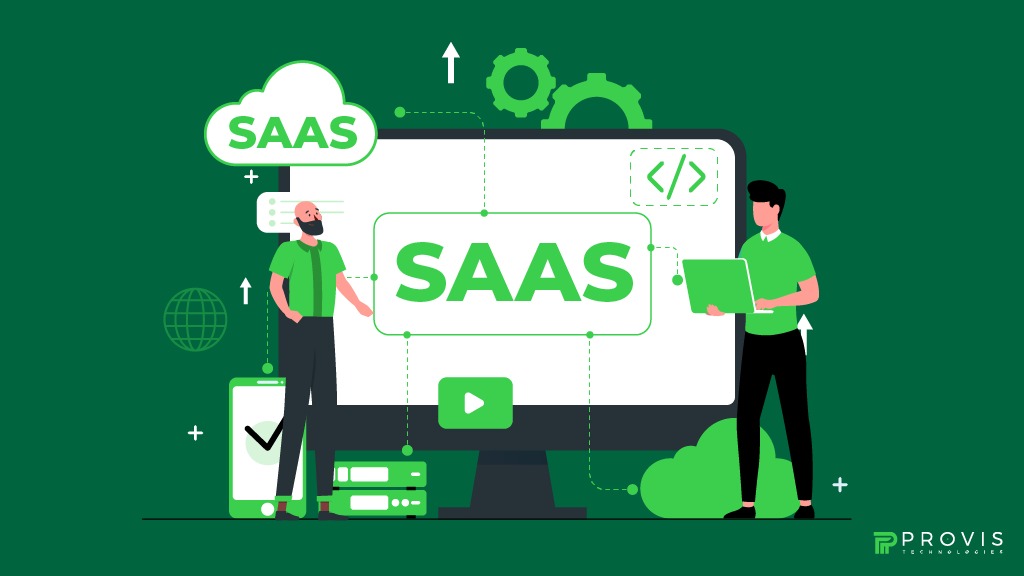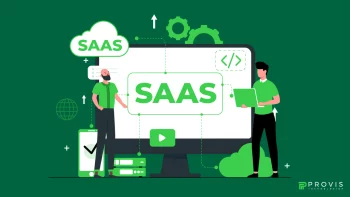In SaaS product development, it’s necessary to build a strategic roadmap. This will guide the product and help it change with the users’ needs, grow to better fit the market, and deliver long-term goals. Think of the SAAS product roadmap as your product’s GPS, which means you have no direction without it. Also, you will waste a lot of time, or the end product will not meet the expected standard. But with the right approach, you can create a useful and easily changeable plan to attract shareholders, investors, creators, and developers.
The SaaS market is on the right track to touch $908 billion by 2030, and the growth rate of the market has firmed up at 18.7%.
This stat makes it essential to have a crisp SAAS product roadmap for the rapidly increasing competition. Therefore, with Provis Technologies, we’ll explain a step-by-step guide to help you create a SaaS product roadmap. If you are a product manager of a startup or a fast-growing SaaS Development Company, this is the right place.
What Is a SaaS Product Roadmap?
A SaaS product roadmap is a long-term plan that defines the vision, objectives, and major milestones of your software as a service product. This can also help your product team and other stakeholders to see where you are going and where your product is expected to be in the future.
A SaaS product roadmap is much less about the “how,” and much more about the “why” and the “what.” It is intended to make sure that teams understand what they are trying to deliver. Also, it focuses on the biggest impact on your business strategy and customer needs.
Key Components of a SaaS Product Roadmap:
- Vision and Objectives: What do you want to achieve with your product?
- Key Features and Updates: What factors will facilitate the achievement of the goals?
- Timelines: When are you going to launch these updates?
- Metrics: How will you measure success?
Why Is a SaaS Product Roadmap Important?
Having a clear and effective roadmap is crucial for several reasons:
1. Alignment Across Teams
A SaaS product roadmap helps developers, marketers, and executives by providing clear direction. It reduces confusion and guarantees that resources are channeled where they can benefit the most. If you’re exploring how to build SaaS from scratch in 2025, having a robust roadmap is an essential starting point to ensure long-term success.
2. Customer-Centric Development
A good SAAS product strategy depends on the ability to map a series of steps based on customer needs and problems. Moreover, operations based on customer needs can help address many features that will foster engagement and loyalty.
3. Flexibility and Focus
Unlike a set of instructions, SAAS product planning must be linear and responsive to market trends or customers’ responses.
Suggested read: How to Build a Custom and Scalable AI SaaS Product
Steps For A Successful SAAS Product Development Process
1. Define Your Product Vision
A SAAS product roadmap example should follow the realization of your goals as they are your long-term visions. Ask yourself:
- How does your product help to solve a problem?
- Who is your target audience?
- What is your long-term mission?
Such a vision acts as the guiding light to align all the decisions for creating your product.
2. Set Clear Goals and Objectives
Ensure to divide your vision into achievable objectives. Also, SAAS product management should align with your overall business strategy and be specific, measurable, achievable, relevant, and time-bound (SMART).
For example:
- There is scope for increasing the user retention rate by 15% in the next quarter.
- Release a new feature that will enhance the onboarding experience by the end of Q3.
3. Understand Your Users’ Needs
Always consider your map to be customer-centric. Moreover, you can research to know their problems, their choice, and desired results. However, in the process of data collection, use only surveys and interviews along with some form of analytics.
Questions to consider:
- Which functions become most popular among users?
- What problems are they facing that your product could solve?
4. Prioritize Features and Initiatives
Not all ideas on paper can (or should) be on your roadmap. Use frameworks like the RICE scoring model (Reach, Impact, Confidence, Effort). It will will help you sort out the feature importance and possibilities to implement them into the product.
Consider these factors when prioritizing:
- Customer Impact: Will this feature significantly improve the user experience?
- Business Value: Will this contribute towards your revenue target and the growth strategy of your business?
- Effort: How many hours and/or days/weeks will it take to write the software?
5. Create a Visual Roadmap
A visual representation is helpful to enhance the ease of sharing. You may use Trello, Jira, Aha!, or other similar programs to have a preview of the end product, including major steps and timeframes.
Types of visual roadmaps include:
- Timeline-based Roadmap: Listed on when features will be implemented.
- Goal-oriented Roadmap: Oriented towards the accomplishment of particular goals.
- Theme-based Roadmap: Groups features under broader themes, such as “Improving Onboarding” or “Enhancing Collaboration.”
6. Communicate and Share Your Roadmap
Your roadmap is only useful if it is communicated to the right audience. Share it with your stakeholders, employees, and sometimes even your consumers – depending on the business context. Remember that you are expected to justify why certain goals are important and have the highest priority.
Tips for effective communication:
- Keep it concise and focused.
- Make it interesting by including visuals.
- Promote feedback and questions from other people.
7. Review and Update Regularly
A SaaS product roadmap is not like a printed map where you draw lines and follow them throughout the journey. One should set meetings periodically (as often as once every three months) to evaluate the results, listen to the feedback, and make necessary changes.
Ask yourself:
- Are we on track to meet our goals?
- Do priorities have to be changed?
- What’s working well, and what’s not?
Common Mistakes to Avoid
1. Being Too Rigid
A SAAS roadmap should give you a direction to follow and not trap you into a certain line of action. Moreover, remember to be agile to respond to changes according to the customer’s needs.
2. Overloading Your Roadmap
When you attempt to add as many features as possible, the approach can backfire and confuse the team. Therefore, only focus on the most important activities and free up some space for other valuable features.
3. Ignoring Customer Feedback
Focus on your users to find information on their preferences. When companies do not pay attention to the feedback of their customers, the service becomes disgraceful.
4. Lack of Clear Goals
It can be a nightmare to find that your roadmap is not more than an unstructured set of goals. Thus, each effort must be aligned with a particular objective.
Tools to Build Your SaaS Product Roadmap
Here are some popular tools that can help you create and manage your roadmap:
- Aha!: A system encompassing many product management facets with a robust roadmap functionality.
- Trello: Great if specific visuals or scheduling is required.
- Jira: Its major use is in agile teams as well as in incorporating roadmaps into development.
- ProductPlan: Specifically designed tool to create and share product roadmaps.
Conclusion
This way, we’ve explained How to build a SAAS product. Also, you’ve obtained a meaningful set of objectives and learned how to prioritize to deliver the value required for the company’s growth.
Written By
Author's Picks
Categories
- AI for Startups
- AI in Web Development
- AI Integration
- AI Platforms
- AI Prompt
- AI Tools
- AI Trading Software
- Android App
- Android vs iOS Development
- Angular
- API
- API Development
- App
- app development
- App Idea
- App User Feedback
- Application
- Artificial Intelligence
- Audit Services
- Automotive Industry
- Awards and Recognition
- Business Consulting
- Business Website
- Chatbots
- CRM
- CRM for Financial Advisors
- Custom CRM
- Custom SaaS
- Custom Website
- Customer Service
- dashboard design
- Developing a Mobile App
- Digital Business
- E-commerce
- EMR Integration
- Finance
- Financial Advisors
- Financial Advisors
- GIT
- Health Insurance
- iOS App
- iOS App Development
- IoT Mobile App Development
- IoT Platforms
- IT Audit Services
- IT Consulting
- IT Strategies
- Java Development
- Laravel
- Lean Canvas
- Learning Management System
- Logistics Apps
- Mobile App Development
- MVP
- Native App
- News Aggregator Site
- OTT
- Outsourcing IT
- Payment Gateway
- predictive analysis
- Product Launch Strategy
- Progressive Web App (PWA)
- Prototype
- Recommender Systems
- Ruby
- SaaS
- SaaS Application
- SaaS Business
- SaaS Company
- SaaS Development
- SaaS Product
- SaaS Project
- Sales Funnel
- SEO
- Shopping Cart
- Software Development
- SSL and TLS
- Startup Checklist
- Technology
- Tetradic Color Scheme
- UI/UX Design Company
- Unit Testing
- User Flow
- User Testing
- Web Development
- Web Performance Optimization
- website Maintenance Services
- Website Migration Service
- Website Speed Optimization
- WooCommerce
- WordPress





